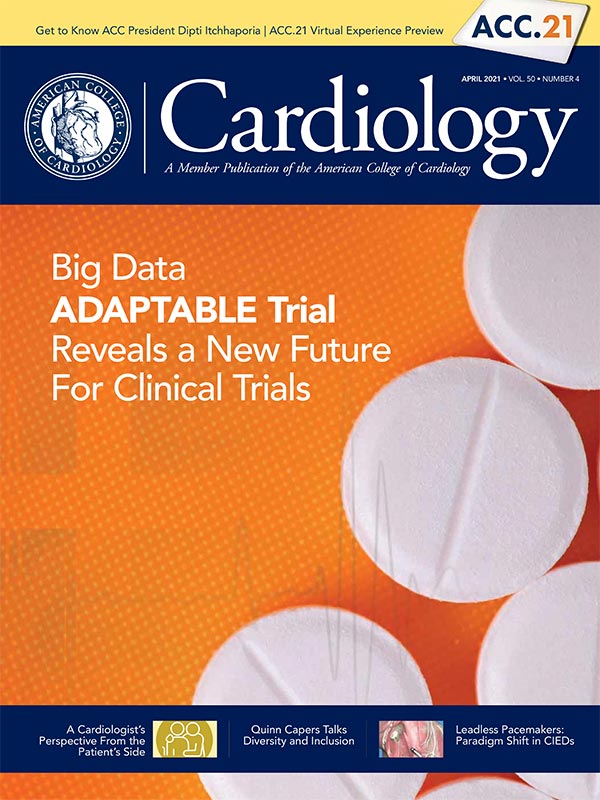Quality Improvement For Institutions | NCDR Research Guiding Practice, Improving Outcome

ACC's NCDR suite of registries are a robust source of data for researchers, and a critical component in continuing to help hospitals, practices and clinicians advance the quality of cardiovascular care and improve patient outcomes.
Recent NCDR research provides insights into the utility of machine learning for mortality prediction after acute myocardial infarction (AMI), how understanding the cost of PCI can help clinicians improve quality, and the safety of operator-directed sedation for pediatric cardiac catheterization laboratory cases.
Read on and then share your thoughts about the findings on Twitter using #NCDR and #CardiologyMag or join in discussions on the ACC's LinkedIn page.
Chest Pain – MI Registry: Limited Improvement With AMI Machine Learning Prediction Model
In recent years, machine learning has been touted for its potential to improve risk prediction models. In a recent study published in JAMA Cardiology, Rohan Khera, MD, MS, et al., used data from ACC's Chest Pain – MI Registry to test whether machine learning could predict patients at higher risk of in-hospital mortality after AMI. The researchers developed and validated three machine learning models to predict in-hospital mortality based on comorbidities, medical history, presentation characteristics and initial laboratory values. The models were based on extreme gradient descent boosting (XGBoost), a neural network and a meta-classifier. Accuracy was compared against the current standard using a logistic regression model in a validation sample.
The study cohort consisted of 755,402 patients with a mean age of 65 years, 65.5% of whom were male. Overall, the primary outcome of death from any cause during hospitalization was 4.4%. The machine learning models showed "modest improvements" in discrimination over logistic regression. The XGBoost and meta-classifier models achieved a discrimination of 0.898 (95% confidence interval [CI], 0.894-0.902) and 0.899 (95% CI, 0.895-0.903), respectively, compared with 0.888 (95% CI, 0.884-0.892) for the logistic regression model.
Calibration slopes improved for the XGBoost and meta-classifier models, but not the neural network model, when compared with logistic regression and applied to a limited or expanded set of variables. In addition, the XGBoost model reclassified 32,393 (27%) individuals and the meta-classifier model reclassified 30,836 (25%) individuals considered to be at moderate or high risk of death in logistic regression as low risk. The reclassification was more consistent with observed event rates.
According to the researchers, "improvements in risk prediction for in-hospital mortality with machine learning models were small and likely do not meet the threshold to be relevant for clinical practice." They conclude that "compared with logistic regression, the models offered improved resolution of risk for high-risk individuals."
The findings "illustrate" that the "generalized linear model is powerful, and only rarely is there a price – a substantial loss of performance – for choosing it," Matthew M. Engelhard, MD, PhD, et al., write in a related editorial comment. They add that "for many clinical prediction tasks, the simpler approach – the generalized linear model – may be all that we need."
CathPCI Registry: Benchmarking Cost of Care For PCI, Improving Quality, Value of Care
A better understanding of the variations in total cost of care for PCI, when evaluated against related quality of care measures in ACC's CathPCI Registry, may help facilities improve the value of care delivery, according to an abstract presented as part of ACC's Cardiovascular Summit Virtual.
In an effort to help hospitals and health systems better understand the relationship between costs and quality for PCI, Steven M. Bradley, MD, MPH, FACC, et al., benchmarked the average total cost of care, in terms of the amounts charged and allowed for reimbursement, for elective and nonelective PCI procedures. The total cost of care was calculated based on the entire PCI episode of care, including all associated services. Cost data are not currently available in the CathPCI Registry.
The ACC partnered with FAIR Health, a convener of claims data, to identify 134 procedure codes that indicate a PCI occurrence, as well as related resource utilization codes. The study included all clinically related billing codes that occurred within the episode of care, defined as 60 days preprocedure through 90 days postprocedure for elective PCIs and 15 days preprocedure through 90 days postprocedure for nonelective PCIs. The researchers then reviewed claims data for adult patients with private insurance who underwent PCI between 2016 and 2019 at facilities participating in the CathPCI Registry. The researchers then stratified the total cost of care by elective vs. nonelective indications to calculate average total cost of care.
Based on preliminary results, the average amount charged for nonelective PCIs increased by 18.8% for men and 35.3% for women. For nonelective PCIs, the amount allowed for reimbursement increased by 18.6% for men and 34.3% for women. For elective PCI, the amount charged increased by 23.9% for men and 29.2% for women, while the amount allowed for reimbursement increased by 1.47% for men and 39.3% for women.
The researchers conclude that the identified variations in total cost of care, when evaluated against related quality of care registry measures, may help improve the value of cardiovascular care delivery. The results may impact clinical practice by enabling cardiovascular clinicians to understand the total cost of care, which can guide them in identifying opportunities to address cost of care while also optimizing outcomes through quality improvement efforts in the CathPCI Registry. The researchers note that these data are a first step in providing cost transparency to sites participating in the CathPCI Registry with "future efforts directed at offering granular insights on cost, quality and outcomes necessary to achieve the goal of high-value care."
The Percutaneous Coronary Intervention Cost of Care Study will be available to sites participating in the CathPCI Registry in spring 2021.
IMPACT Registry: Operator-Directed Sedation Safe, Efficient in Pediatric Cardiac Cath Lab Cases
Use of operator-directed sedation (ODS) and anesthesiologist care in pediatric cardiac catheterization laboratory procedures may be safe and efficient, according to a study published in JACC: Cardiovascular Interventions.
Using data from ACC's IMPACT Registry, Michael L. O'Byrne, MD, MSCE, et al., looked at procedures performed with either ODS or anesthesia at hospitals participating in the registry between 2011 and 2018 that used ODS for ≥5% of cases. The researchers compared risks for major adverse events (MAE) for ODS and anesthesia. Current recommendations were used to compare the ratio of observed to expected MAE for cases in which ODS was inappropriate with those for similar risk for anesthesia care cases, as well as for cases in which ODS or anesthesia care was appropriate.
During the study period, 28 hospitals used ODS for more than 5% of total case volume. These 28 hospitals performed 37,927 cases, 7,042 (23%) of which were performed using ODS. The percentage of cases using ODS decreased during the study period – from 19% in 2011 to 3.9% in 2018. The proportion of infants (age 30 days to 1 year) was lower in the ODS cohort, while the proportion of adults (≥18 years) was higher. Patients in the ODS cohort were less likely to have genetic syndromes, chronic lung disease, single ventricles, renal insufficiency and preprocedural inotropes.
Overall, the total risk for all MAE was 7% and was higher in the anesthesia cohort (7%) vs. the ODS cohort (4%). In-hospital deaths within 30 days were more common in patients receiving anesthesia (1.9%) vs. ODS (0.6%). In addition, anesthesia care was associated with a higher risk for cardiac arrest, new arrhythmia, device malposition, vascular complications and miscellaneous adverse events. ODS was associated with a higher risk for dialysis initiation, tamponade and airway events. After adjusting for preprocedural risk, anesthesia care was associated with increased odds of MAE compared with ODS (odds ratio, 1.2; 95% CI, 1.03-1.4; p=0.02).
The study shows that, "for a subset of [pediatric cardiac catheterization laboratory] procedures, that the use of ODS is associated with high-quality efficient care and that there is no evidence (for this subset of procedures) that the alternative use of [anesthesia care] would improve outcomes," the authors write. "These findings should inform future guidelines governing the use of procedural sedation," they conclude.
ACC Launches EP Device Implant Registry, Expanding Scope of Former ICD Registry
The ACC has changed the name of its ICD Registry to the EP Device Implant Registry, effective April 1. The EP Device Implant Registry will include data on ICD and CRT-D procedures previously captured in the ICD Registry, as well as provide flexibility to capture novel pacemaker procedures. In addition, the EP Device Implant Registry now allows participants to capture data on shared decision-making, a compliance requirement for the Centers for Medicare and Medicaid Services' national coverage determination for ICD/CRT-D primary prevention device implants. The registry also fully supports the data requirements for ACC Accreditation Services Electrophysiology Accreditation, fully supporting the program's data requirements. For more information, visit ACC.org/EPDeviceRegistry.
Look For NCDR Research at ACC.21
Research using data from NCDR registries will be featured throughout ACC.21, including a Featured Clinical Research (FCR) presentation from the LAAO Registry on "One-Year Clinical Outcomes Following Watchman Transcatheter Left Atrial Appendage Occlusion For Stroke Prevention in Patients With Atrial Fibrillation."
Search "NCDR" in the ACC.21 Online Program Planner for more. Check out the full lineup of the meeting's Late-Breaking Clinical Trials and FCR Sessions in the program planner.
Keywords: ACC Publications, Cardiology Magazine, Quality Improvement, National Cardiovascular Data Registries, Treatment Outcome, Outcome Assessment, Health Care, Registries
< Back to Listings

